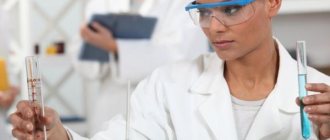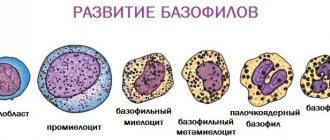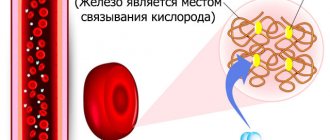What is hemoglobin
Hemoglobin is a protein found in red blood cells. This element acts as a connecting link in metabolism, as it transports oxygen to all internal structures of the body and removes carbon dioxide from them. In addition to helping tissues “breathe,” the protein performs a pigment function, in other words, it gives the blood fluid a red tint.
Fluctuations in the required level of hemoglobin in the blood may indicate a pathological or some kind of stressful condition.
If any changes in the amount of hemoglobin are detected, patients are sent for additional studies, which help to reconstruct a complete clinical picture, and also allow one to diagnose/refute the presence of possible diseases.
Table of hemoglobin norms in the blood of women by age
Women experience many different hormonal changes throughout their lives, which are treated by an endocrinologist. They may be associated with physical overexertion, frequent stress, pregnancy, menstruation or menopause. For these reasons, enzyme concentrations may vary throughout the month and do not indicate the presence of any pathological processes in the body. In addition, depending on the age of the patient, protein levels will also vary.
Nowadays you can find a lot of information on the Internet regarding the norms of various blood parameters, including hemoglobin. The figures indicated there are far from the real situation. The medical guidelines used by doctors indicate clear ranges - the minimum and maximum of each indicator. There is "from and to" for all ages. To treat the patient and determine the further prognosis. For hemoglobin, both the upper and lower limits of normal are important
The standard hemoglobin level in women varies from 120 to 150 g/l. You can evaluate the results of the analyzes by checking the indicated values with the tabular data.
Hemoglobin norm in women - table by age:
| Woman's age | Hemoglobin norm, g/l. |
| 17 — 20 | 120 — 150 |
| 21 — 30 | 120 — 150 |
| 31 — 40 | 120 — 145 |
| 41 — 50 | 120 — 140 |
| 51 — 60 | 120 — 140 |
| 61 — 65 | 120 — 140 |
| more than 65 | 120 — 150 |
Normal hemoglobin level in women aged 30–40 years
The norm at 40 years is at its highest level, after which it gradually begins to decline. Such modifications are associated with hormonal changes in the body that begin to occur during this period. The process of minimizing the concentration of the enzyme in the blood continues throughout subsequent years. Compared to thirty-year-old women, at 40 years old the protein content decreases by 5 g/l.
Normal after 50 years
After 50 years, the norm of hemoglobin in the blood of women decreases noticeably . These modifications can be clearly seen in the table; the indicated indicators do not correspond to normal values. Such disorders are associated with hormonal and emotional instability. Women at this age are susceptible to depression, various experiences) and quickly get tired even with minimal physical exertion (the help of a psychologist can help cope with such conditions.
Normal for women after 60
As indicated in the table, the hemoglobin level in women after 60 years of age becomes critical. This situation is associated with the end of menopausal changes and the minimization of metabolic processes in the body. Hemoglobin in women after 65 years of age has critical indicators, as internal metabolism in tissues slows down.
Reasons for the increase
Paradoxically, the same reasons provoke an identical hemoglobin deficiency. The only difference is how the body reacts to dysfunction. The probability of encountering an increase or decrease is approximately 50% to 50%.
Diabetes
If in the past case the body strives to compensate for the deficiency, here the opposite is true. The body fails to cope from the very beginning. Meanwhile, hemoglobin molecules bind well to saccharides.
Such a system becomes inextricable. The bonds in the substance are too strong. Therefore, tissues receive much less oxygen.
In this case, the body uses large amounts of energy to tear off oxygen atoms. That is, cellular respiration takes too much effort, but gradually the body gets tired of this state of affairs.
It is necessary to prescribe a diet and use insulin as soon as possible. Then the situation will return to normal.
Pathologies of the heart and blood vessels
High hemoglobin in women occurs in diseases ranging from myocardial infarction to widespread atherosclerosis. When a large amount of cholesterol is deposited on the walls of the arteries. Read about the reasons for high cholesterol in women in this article.
Plaques develop and interfere with blood flow. Either alone or when such a problem is combined with low cardiac output, nutrition becomes poor. So is breathing. In order to somehow restore the functioning of the body, the body tries to synthesize more hemoglobin.
At this stage, dangerous consequences are possible. Because formed cells are also produced in much larger quantities.
Attention:
Violations pose a critical danger. Not only because of hemoglobin, but also on their own. Heart attacks and strokes are possible.
Kidney pathologies
Normally, about 1-2 liters of urine are excreted per day. Depending on how much liquid a person consumes.
If the paired organ cannot work and filter urine, the water simply comes out. By the way, the kidneys clean up to several tens of liters of fluid per day. This is a normal physiological phenomenon.
With pyelonephritis, failure, disorders develop. More than 3-5 liters of water comes out, the body suffers from dehydration.
The body strives to compensate for breathing. But it won't last long. With great endurance, a critically high level of hemoglobin is possible. Then dysfunction still occurs. However, at high levels of the substance, the blood becomes thicker. This is an additional risk.
Treatment. Diuretics, anti-inflammatory, antibiotics. Stimulators of antibody production. Like options.
Often the problem is not hidden in the kidneys. Diabetes insipidus, which causes excessive urination, is a purely endocrine disorder. Little vasopressin is produced, a hormone that prevents fluid from leaking beyond normal limits.
Here the treatment will be different. Medicinal or surgical, if a tumor is to blame.
Bone marrow disorders
Both in one direction and in the other. In the described case, it works too actively. Why this happens is another question. Usually these are genetically determined processes.
Treatment. If the disorder does not negatively affect the tissues, the body is fine, then nothing needs to be done. When hypercoagulation develops, the blood clots quickly, and antiplatelet agents are prescribed. Anticoagulants are also used as needed.
If therapy is ineffective, drugs are prescribed to suppress bone marrow function. But this is an extremely undesirable measure. An extreme way to correct the condition.
Malignant oncology
Cancer cells absorb most of the oxygen. The larger the size of the neoplasia and the more intensely it grows, the worse the situation.
The body copes in the early stages. Produces a lot of hemoglobin, but almost all transport goes to cancer. Then critical dysfunction occurs.
Tumors of the reproductive system are the most dangerous; elevated hemoglobin in women is always detected in the later stages. Many of them are extremely aggressive. They quickly metastasize and grow infiltratively, piercing and destroying neighboring tissues.
Treatment. The therapy is complex. The tumors must be surgically removed. This is not so easy to do. Chemotherapy and radiation therapy are then applied as needed.
It is important to closely monitor the results of MRI, tumor markers and the blood test itself.
Injuries
Including thermal and chemical burns. Causes large amounts of fluid to leave the body. Hence dehydration and increased hemoglobin concentration.
Treatment consists of correcting injuries and damage.
High hemoglobin levels in women are caused by a number of reasons. Changes in indicators affect the concentration of hormones. This means that representatives of this part of humanity will encounter difficulties when conceiving or bearing a child.
Such problems need to be thought about separately, at the stage of pregnancy planning. So that violations do not become an unpleasant surprise.
Table of hemoglobin norms in men by age
In men, the concentration of hemoglobin in the blood differs significantly from the normal values of the enzyme in women. So, in the male half, its content should not decrease to 130 g/l. and rise above the level of 170 g/l.
Such differences are associated with the production of testosterone in men, which can further enrich blood cells with oxygen.
In addition, the energy costs of the stronger sex are larger, which means the need for air exchange increases.
The norm of hemoglobin in the blood of men, depending on age, is shown in the table:
| Age | Normal hemoglobin g/l. |
| 15 — 18 | 120 — 155 |
| 18 — 30 | 130 — 170 |
| 30 — 40 | 130 — 155 |
| 40 — 60 | 130 — 160 |
The hemoglobin level in men after 30 years gradually begins to decrease. These differences can be analyzed using the table. Such changes are directly related to testosterone production.
As you know, after 40 years, the production of the hormone decreases, and therefore, male libido is gradually suppressed (consultation with a sexologist can solve this problem)
Against the background of ongoing processes, the physical activity of a man is similarly minimized.
In men after 50–60 years, the concentration of the enzyme is minimized, since testosterone virtually ceases to be produced. Therefore, it is regularly necessary to monitor the indicators of blood components and undergo tests. Any deviation from normal values (as indicated in the table) should be immediately eliminated, since at this age there is a high risk of developing anemia and other pathologies associated with the abnormal composition of the blood fluid.
Table of hemoglobin norms in children by age
In newborns, the density of hemoglobin in the blood has maximum values. Then its content gradually decreases, a certain stability of indicators appears only at 6 months. This condition persists until the child reaches 5 years of age, after which the concentration of the enzyme begins to increase again.
It is also worth considering that when a child reaches the age of 12 years, it is necessary to analyze protein indicators based on his gender. They will be different for boys and girls.
The norm of hemoglobin in the blood of children by age is shown in the table:
| Age | Boys | Girls |
| from 0 to 15 days. | 160 — 200 | 160 — 200 |
| 1 - 3 months | 120 — 160 | 120 — 160 |
| 4 - 6 months | 95 — 140 | 95 — 140 |
| 6 – 12 months | 110 — 145 | 114 — 150 |
| 1 - 2 g. | 110 — 130 | 110 — 130 |
| 2 - 5 l. | 105 — 150 | 105 — 145 |
| 5 - 11 l. | 110 — 140 | 110 — 140 |
| 12 - 14 l. | 120 — 140 | 120 — 140 |
| 15 - 17 l. | 120 — 155 | 120 — 150 |
Normal hemoglobin level in blood during pregnancy
During pregnancy, a woman’s amount of enzyme in her blood will differ from the values indicated in the table above. Also, pregnant women should know what medications can and cannot be taken during pregnancy. These deviations are associated with various changes that occur in the body.
Approximate indicators of enzyme content in pregnant women are shown in the table:
| Trimester | Amount of hemoglobin g/l. |
| 1 | 115 — 165 |
| 2 | 110 — 145 |
| 3 | 110 — 140 |
These differences are associated with the end of menstruation and the subsequent growth of the placenta, which requires constant nutrition. Therefore, it is important for the expectant mother to systematically undergo blood tests, since a critical decrease/increase in hemoglobin can become a source of dangerous complications (hypoxia, abnormal fetal development, early birth, underweight of the baby, retardation in mental/physical development, etc.).
Doctor's advice
Often the cause of increased hemoglobin is non-compliance with the drinking regime. The body receives little fluid (less than 1.5-2 liters of clean water per day, tea, coffee and other liquids do not count), this causes the blood to thicken. In this condition, not only hemoglobin, but other indicators also increase - hematocrit, red blood cells, platelets. Hematologists advise that if you have anemia, your diet should focus on meat. Liver and buckwheat are in second place in importance. Next are apples, nuts, cocoa. These same principles apply not only to adults, but also to children.
Victoria Druzhikina Neurologist, Therapist
Prevention methods
It is easier to prevent any disease than to cure it. Therefore, it is worth taking a blood test at least once a year. This will help identify violations at the earliest stages. It is recommended to stop smoking cigarettes. Along with tobacco smoke, carbon monoxide enters the bloodstream, which greatly complicates the transport of oxygen to blood cells.
You should exercise regularly and take walks in the fresh air. Nutrition should be complete. It is necessary to ensure that the body receives a sufficient amount of vitamins and microelements.
It is very important for men to ensure that hemoglobin levels are normal. This will prevent a number of diseases and always maintain good health. If the first symptoms of abnormalities occur, you should take a blood test and consult a doctor. It is not recommended to self-diagnose; anemia and hyperhemoglobinemia can occur against the background of serious diseases. First of all, it is necessary to exclude the presence of the disease, and only then carry out treatment.
Hemoglobin level in women during menstruation
During the menstrual period, protein content decreases sharply. This feature of the female body is associated with loss of blood fluid and is not a sign of pathology. It is for this reason that women feel unstable during menstruation:
- dizziness occurs (about other causes of dizziness here);
- appetite increases;
- there is a persistent feeling of fatigue, etc.
At the same time, experts recommend refraining from taking blood tests a few days before/after menstruation, as the information will be distorted. The normal level of hemoglobin after menstruation is restored within 2 – 3 days (with correct nutrition and lifestyle).
Hemoglobin level - how to find out?
It is impossible to do this by eye. Of course, there are certain signs that allow one to suspect trouble, but, unfortunately, a woman often attributes the symptoms to fatigue, bad mood, etc., postponing a visit to the doctor. In addition, diseases are often asymptomatic at the initial stage, and detecting the disease at its very beginning is problematic. That is why there are preventive examinations that should be performed regularly. Increased or decreased hemoglobin levels can be determined using a blood test ; the test can be done in any laboratory.
Blood test for hemoglobin
Blood for examination should be donated in the morning on an empty stomach; you are allowed to drink only water. But it should be noted that the result will be inaccurate during menstruation, so it is better to postpone the examination for several days. In addition, you cannot donate blood after physiotherapeutic procedures, ultrasound and x-ray examinations, as the results will be distorted. However, a change in hemoglobin concentration can be caused by injury, dietary habits, for example, a passion for vegetarianism, so a doctor should write a referral for examination. The interpretation of the results obtained should also be entrusted to specialists.
Causes and symptoms of low hemoglobin
Iron deficiency anemia is a fairly dangerous and common condition in which the blood cell content is less than the lower limit of normal.
In this case, the patient may have the following symptoms:
- vertigo;
- severe fatigue;
- change in taste preferences;
- frequent headaches (read how to get rid of headaches in this article);
- dyspnea;
- decreased blood pressure;
- decreased muscle tone;
- brittle nails/hair.
The danger of decreasing hemoglobin levels is that the brain and other internal structures do not receive the required amount of oxygen, and therefore cease to function correctly. As a result, associated health problems appear that significantly affect the quality of life.
The main reasons for a decrease in hemoglobin in the blood:
- poor nutrition (frequent diets, lack of vitamins, etc.);
- chronic gastritis (here you can find effective tablets for stomach pain)
- chronic pyelonephritis;
- arthritis;
- hepatitis;
- dysbacteriosis;
- tuberculosis;
- blood loss (after operations, injuries).
Increased hemoglobin - etiology and symptoms
It should be noted that hemoglobin above normal is diagnosed much less often than low, but is no less dangerous to human health.
The reason for this violation may be the following:
- extreme sports or working at heights;
- accommodation in mountainous areas;
- smoking, alcohol abuse;
- fibrosis;
- cardiovascular diseases;
- extensive blood transfusions;
- oncological processes in the body;
- hormonal disorders;
- disturbances in the gastrointestinal tract;
- deficiency of vitamin B and folic acid;
- adherence to a diet that is not medically justified.
An increased concentration of this protein in the body in women or men due to age leads to the fact that the blood becomes more viscous, which significantly increases the risk of blood clots. Therefore, this factor should always be kept under control, and for this there is a table - hemoglobin, the norm for women by age.
The clinical picture of an increased indicator will be characterized as follows:
- loss of appetite or lack thereof;
- increased fatigue;
- headaches, frequent fainting;
- pallor of the skin or, on the contrary, redness;
- drowsiness, even if the person is resting fully and comfortably;
- high blood pressure.
Such concentration levels are not the norm for men or women of any age. Moreover, the presence of such a pathological process significantly increases the risk of stroke, heart attack and other diseases with a similar etiology.
Symptoms of high and low hemoglobin
How to increase hemoglobin in the blood
It is important to control the ratio of all components of the blood fluid. Since its minimization is a pathological condition that will require certain treatment, and it does not always go away quickly and successfully. As therapy, doctors can take measures such as:
- blood transfusion (used in extreme cases, when the level is greatly reduced and drug treatment fails);
- prescription of vitamins (B9 and B12);
- taking iron-containing medications (in the form of tablets, suspensions or injections);
- drawing up a special menu (iron-enriched foods are added to the diet - meat, liver, herbs, vegetables, buckwheat, dried fruits, seafood, chocolate, etc.)
Therapy to increase hemoglobin levels in the blood is prescribed by a doctor during a personal appointment or online consultation. You can consult online or consult with a service doctor.
Reasons for the low rate
Reduced hemoglobin is a fairly common occurrence, occurring in a third of women, and 8% have iron deficiency anemia. According to WHO, more than one and a half billion people suffer from this pathology. A low level of hemoglobin in the blood in women is called anemia, which is classified according to severity:
- mild degree - hemoglobin drops to 90 units, is detected by chance during a medical examination, does not have pronounced symptoms, the patient may be bothered by weakness, sweating, lack of appetite, and fatigue;
- average severity of anemia - hemoglobin reaches a level of at least 70 units: vertigo, cephalalgia, tachycardia, constipation, flatulence, seizures occur, the skin takes on a sloppy appearance, acquiring roughness;
- severe anemia - the hemoglobin level drops below 70 units, a pre-fainting state appears, fainting, spots before the eyes, blood pressure drops, menstruation stops, the skin is pale, hair, nails become dull, brittle, limbs are cold, aphthae occur, teeth are destroyed, minimal exercise is required long rest.
The causes of low hemoglobin in women are pathologies of internal organs, unbalanced nutrition (diet, vegetarianism), stress, psycho-emotional overload, hereditary or acquired bone marrow diseases, diabetes mellitus, tumors, coronary artery disease, dehydration, blood loss of various origins, and thyroid pathology.
Sometimes the cause of anemia is foods that impair iron absorption: chocolate, tea and coffee.
To prevent and treat such anemia, you need iron supplements, vitamins B12 and C, and folic acid. The main sources of iron are meat and offal. In addition, iron is found in eggs, dried fruits, beans, buckwheat, green apples, and leafy vegetables. Natural juices are needed: pomegranate, apple, rosehip decoction.
Treatment of anemia is always associated with an accurate diagnosis of the root cause and its elimination.
Hemoglobin level for women is the most important indicator of health, which must be monitored regularly. This is especially important for pregnant and elderly women.
High hemoglobin: causes, treatment
If hemoglobin levels in the blood exceed the norm indicated in the table, then this condition is also a reason to consult a doctor. In this case, the patient may have symptoms such as:
- problems in the functioning of the genitourinary system;
- drowsiness;
- yellowish skin;
- poor appetite;
- decreased vision;
- oncology;
- chronic heart failure;
- high fatigue.
The reasons for such a violation include:
- diabetes mellitus (the disease is treated by an endocrinologist);
- increased blood viscosity;
- erythrocytosis;
- excess vitamin B12/B9;
- chronic obstructive pulmonary diseases.
Causes of elevated hemoglobin
The hemoglobin level is different for men and women. It is considered normal that in healthy men its content is higher than in women. This is due to the presence of testosterone in the blood of the stronger half.
In the presence of physical activity, the body's need for hemoglobin immediately increases. Typically, a man experiences more intense stress in life, and his oxygen consumption is higher.
Athletes, pilots or the population of high mountainous areas need not worry if their hemoglobin is slightly elevated. These people feel good with these indicators. But when the protein content is increased in an ordinary man, the general condition of the body deteriorates. Causes of elevated hemoglobin levels:
- diseases of the cardiovascular and genitourinary systems;
- dehydration;
- prolonged stressful situations, severe nervous tension;
excessive physical activity;
- skin damage (burns, wounds);
- diabetes;
- disease of the digestive system, intestinal obstruction;
- oncological diseases;
- hypervitaminosis (excessive content of B vitamins);
- smoking;
- poisoning with toxic substances or drugs.
The consequences of an increased content of iron-containing protein can be problems with sleep (insomnia or drowsiness), headache, nervousness, loss of energy, dizziness, tinnitus, decreased appetite, and muscle pain. With a high content of iron-containing protein, the consistency of the blood becomes too thick. This provokes blockage of blood vessels, the occurrence of blood clots, cholesterol plaques, and increases the likelihood of strokes, heart attacks, thrombosis and heart attacks. Excess hemoglobin negatively affects the functioning of the urinary system .
Frequently asked questions and doctor's answer
General practitioner Victoria Druzhikina answered questions
1. What is Hemoglobin indicated in a blood test?
- “In a general blood test, hemoglobin is abbreviated as Hb, measured in grams per liter.” 2. Why is low Hemoglobin dangerous?
– “Low hemoglobin levels are dangerous due to anemia and its consequences:
- oxygen starvation of organs and tissues, primarily nervous;
- muscle weakness;
- fainting due to decreased blood pressure;
- decreased immunity;
- wear and tear of the heart muscle due to the development of compensatory tachycardia in conditions of lack of oxygen;
- heart attacks;
- retardation in mental and physical development.
In severe cases, untreated anemia can lead to hypoxic coma and death due to brain or heart failure.”
3. Blood transfusion for low hemoglobin
– “To treat severe forms of anemia, blood or red blood cell transfusions are used. The procedure is indicated in 2 cases:
1. With a hemoglobin level of 70 g/l and below.
2. In case of poor tolerance to anemia and the threat of hypoxic coma at any level of hemoglobin. This can occur in people whose lives involve high oxygen consumption - pregnant women, athletes, scuba divers playing wind instruments.
The standard regimen is 2 doses (1 dose – 200 ml) twice a week. Before and after the procedure, general urine and blood tests and temperature must be monitored.
Before the manipulation, the patient’s blood type and Rh factor are determined, and donor blood is selected based on these indicators. Next, the compatibility of the blood samples is checked. If the reaction proceeds normally, a transfusion is performed. If flakes or clots form, this blood is not transfused, but other samples are tested for compatibility.” 4. Hemoglobin norm in children under one year old
– “The hemoglobin norm in children under one year of age is determined by physiological factors. By the end of the 1st month, the numbers are higher than in adults and amount to 160–200 g/l.”
5. How to increase Hemoglobin in a child?
“If anemia is detected, it is important to increase hemoglobin levels as soon as possible, especially in children. The main role in this belongs to drugs. Unfortunately, nutrition will not significantly increase the numbers. With the help of food, you can only slightly improve your performance and maintain it at this level.
Foods to increase hemoglobin in children:
- beef;
- buckwheat;
- cocoa;
- liver;
- apples;
- pomegranate;
- walnuts.
Drugs for the treatment of anemia in children:
- Maltofer;
- Ferrum Lek;
- Totema;
- Ferlatum and others"
6. How to increase hemoglobin during pregnancy?
“During pregnancy, it can be difficult for a woman to follow a diet with foods rich in iron. However, their list is quite wide, you can choose what you like:
- beef;
- wheat bran;
- hazelnuts;
- cabbage, including broccoli;
- chocolate;
- rabbit;
- liver;
- cocoa;
- apples;
- pears;
- parmesan, etc.
How to increase hemoglobin during pregnancy - the most used drugs:
- Maltofer;
- Sorbifer Durules;
- Ferrum Lek;
- Gyno-tardiferon;
- Totema;
- Ferlatum and others."
7. Iron supplements to increase hemoglobin in adults
– “To treat anemia in adults, the same drugs are used as for pregnant women. Can also be used:
- Venofer;
- Ferlatum protein;
- Cosmopher;
- vitamin complexes with iron (Ferro-Folgamma, Fenyuls, etc.).”
8. Normal Hemoglobin in Newborns? – “The hemoglobin norm varies slightly from month to month, the generally accepted average values are 120–160 g/l.
Immediately after birth, the mother’s blood circulates in the baby, so values from 180 to 240 g/l are considered normal for the 1st week of life.”
For information on hemoglobin levels, see also the video:
This article has been verified by a current qualified physician, Victoria Druzhikina, and can be considered a reliable source of information for site users.
Bibliography
1. The norms of indicators are specified in Appendix No. 3 of Order of the Ministry of Health of the Russian Federation dated 09/14/2001 364 (as amended on 06/06/2008)
Rate how useful article
5 was. 23 people voted, average rating 5
Did you like the article? Save it to your wall so you don’t lose it!











